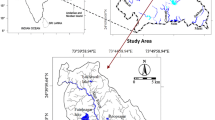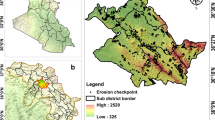Abstract
The universal soil loss equation (USLE) is an erosion model to estimate average soil loss that would generally result from splash, sheet, and rill erosion from agricultural plots. Recently, use of USLE has been extended as a useful tool predicting soil losses and planning control practices by the effective integration of the GIS-based procedures to estimate the factor values on a grid cell basis. This study was performed for five different lands uses of Indağı Mountain Pass, Cankırı to predict the soil erosion risk by the USLE/GIS methodology for planning conservation measures in the site. Of the USLE factors, rainfall-runoff erosivity factor (USLE-R) and topographic factor (USLE-LS) were greatly involved in GIS. These were surfaced by correcting USLE-R site-specifically using DEM and climatic data and by evaluating USLE-LS by the flow accumulation tool using DEM and watershed delineation tool to consider the topographical and hydrological effects on the soil loss. The study assessed the soil erodibility factor (USLE-K) by randomly sampled field properties by geostatistical analysis. Crop management factor for different land-use/land cover type and land use (USLE-C) was assigned to the numerical values from crop and flora type, canopy and density of five different land uses, which are plantation, recreational land, cropland, forest and grassland, by means of reclassifying digital land use map available for the site. Support practice factor (USLE-P) was taken as a unit assuming no erosion control practices. USLE/GIS technology together with the geostatistics combined these major erosion factors to predict average soil loss per unit area per unit time. Resulting soil loss map revealed that spatial average soil loss in terms of the land uses were 1.99, 1.29, 1.21, 1.20, 0.89 t ha−1 year−1 for the cropland, grassland, recreation, plantation and forest, respectively. Since the rate of soil formation was expected to be so slow in Central Anatolia of Turkey and any soil loss of more than 1 ton ha−1 year−1 over 50–100 years was considered as irreversible for this region, soil erosion in the Indağı Mountain Pass, to the great extent, attained the irreversible state, and these findings should be very useful to take mitigation measures in the site.







Similar content being viewed by others
References
Akman Y (1995) Türkiye Orman Vejetasyonu, Ank Üniv Fen Fakültesi Botanik Ana Bilim Dalı (in Turkish), Ankara, pp 143–154
Aytuğ B (1970) Arkeolojik araştırmaların ışığı altında İç Anadolu Stepi, İ. Ü. Orman Fa k (in Turkish). Dergisi, Seri A 20(1):127–143
Bartsch KP, van Miegroet H, Boettinger J, Dobrwolski JP (2002) Using empirical erosion models and GIS to determine erosion risk at Camp Williams. J Water Conserv 57:29–37
Basaran M, Ozcan AU, Erpul G, Çanga MR (2006) Spatial variability of organic matter and some soil properties of mineral topsoil in Çankiri İndagi blackpine (Pinus nigra) plantation region. J Appl Sci 6(2):445–452
Basaran M, Erpul G, Tercan AE, Canga MR (2007) The effects of land use changes on some soil properties in İndağı Mountain Pass, Çankırı, Turkey (in press)
Bayramin I, Erpul G, Erdogan HE (2006) Use of CORINE methodology to assess soil erosion risk in the semi-arid area of Beypazari, Ankara. Turk J Agric For 30:81–100
Beurden SAHA, van Riezebos HTh (1988) The application of geostatistics in erosion hazard mapping. Soil Technol 1(4):349–364
Boardman J (1988) Severe erosion on agricultural land in East Sussex, UK, October (1987). Soil Technol 1:333–348
Burgess TM, Webster R (1986) Optimal interpolation and isarithmic mapping of soil properties: II. Block kriging. J Soil Sci 31:333–344
Burrough PA (1986) Principles of geographical information system for land resources assessment. Clarendon Press, Oxford
Celik I (2005) Land-use effects on organic matter and physical properties of soil in a southern Mediterranean highland of Turkey. Soil Till 83(2):270–277
Cerda A (1996) Soil aggregate stability in three Mediterranean environments. Soil Technol 9:133–140
Cerri CEP, Dematte JAM, Ballester MVR, Martinelli LA, Victoria RL, Roose E (2001) GIS erosion risk assessment of the Piracicaba River Basin, southeastern Brazil. Mapp Sci Remote Sens 38:157–171
Desmet PJJ, Govers G (1996) A GIS procedure for automatically calculating the USLE LS factor on topographically complex landscape units. J Soil Water Conserv 51:427–433
Dogan O (2002) Erosive potentials of rainfalls in Turkey and erosion index values of universal soil loss equation. Publications of Ankara Research Institutes. General Directorate of Rural Service, Turkey. Publication no. 220, Report no:R-120
EEA (1999) Environment in the European Union at the Turn of the Century. Environmental assessment report 2
Eedy W (1995) The use of GIS in environmental assessment. Impact Assess 13:199–206
Erdoğan EH, Erpul G, Bayramin İ (2006) Use of USLE/GIS methodology for predicting soil loss in a semi-arid agricultural watershed (in press)
Evrendilek F, Celik I, Kilic S (2004) Changes in soil organic carbon and other physical soil properties along adjacent Mediterranean forest, grassland, and cropland ecosystems in Turkey. J Arid Environ 59:743–752
Foster GR, McCool DK, Renard KG, Moldenhauer WC (1981) Conversion of universal soil loss equation to SL metric units. J Soil Water Conserv 36:355–359
Goovaert P (1999) Geostatistics in soil science: state of the art and perspective. Geoderma 38:45–93
Grimm M, Jones RJA, Rusco E, Montanarella L (2003) Soil erosion risk in Italy: a revised USLE approach. European Soil Bureau Research Report No.11, EUR 20677 EN, (2002). Office for official publications of the European communities, Luxembourg, p 28
Haynes RJ (1999) Size and activity of the soil microbial biomass under grass and arable management. Biol Fertil Soils 30:210–216
Hession WC, Shanholtz VO (1988) A geographic information system for targeting non point-source agricultural pollution. J Soil Water Conserv 43(3):264–266
Journal AG, Huijbregts CS (1978) Mining Geostatistics. Akademic, New York, pp 600
Kinnell PIA (2001) Slope length factor for applying the USLE-M to erosion in grid cells. Soil Till Res 58:11–17
Klik A, Truman CC (2003) What is a typical rainstorm? In: Gabriels D, Cornelis W (eds) proceedings of international symposium, 25 years of assessment of erosion, 22 Ð 26 September, 2003. Ghent, Belgium, pp 93–98
Lal R, Blum WH (1997) Methods for assessment of soil degradation. CRC Press, LLC
Lee S (2004) Soil erosion assessment and its verification using the Universal Soil Loss Equation and geographic information system: a case study at Boun, Korea. Environ Geol 45:457–465
Lu D, Lı G, Valladares GS, Batistella M (2004) Mapping soil erosion risk in Rondonia, Brazilian Amazonia: Using RUSLE, remote sensing and GIS. Land Degrad Dev 15:499–512
Ma JW, Xue Y, Ma CF, Wang ZG (2003) A data fusion approach for soil erosion monitoring in the Upper Yangtze River Basin of China based on universal soil loss equation (USLE) model. Int J Remote Sens 24:4777–4789
Martin A, Gunter J, Regens J (2003) Estimating erosion in a riverine watershed, Bayou Liberty—Tchefuncta River in Louisiana. Environ Sci Pollut Res 4:245–250
Matheron G (1965) Principles of geostatistics. Econ Geol 58:1246–1266
Millward AA, Mersey JE (1999) Adapting the RUSLE to model soil erosion potential in a mountainous tropical watershed. Catena 38:109–129
Moore ID, Burch GJ (1986a) Modeling erosion and deposition. Topographic effects Trans Am Soc Agric Eng 29:1624–1630 1640
Moore ID, Burch GJ (1986b) Physical basis of the length-slope factor in the universal soil loss equation. Soil Sci Soc Am J 50:1294–1298
Ogawa S, Saito G, Mino N, Uch Da S, Khan NM, Shafiq M (1997) Estimation of soil erosion using USLE and Landsat TM in Pakistan, GIS development. Net, ACRS, pp 1–5
Ouyang D, Bartholic J (2001) Web-based GIS application for soil erosion prediction. ASAE, pp 260–263
Özhan S, Balcı N, Özyuvacı N, Hızal A, Gökbulak F, Serengil Y (2005) Cover and management factors for the universal soil-loss equation for forest ecosystems in the Marmara region, Turkey. For Ecol Manage 214:118–123
Parysow p, Wang G, Gertner G, Anderson AB (2003) Spatial uncertainty analysis mapping soil erodibility based on joint sequential simulation. Catena 736:1–14
Poesen JW, Boardman J, Wilcox B, Valentin C (1996) Water erosion monitoring and experimentation for global change studies. J Soil Water Conserv 1996:386–390
Renard KG, Foster GA, Weesies DA, Mccool DK, Yoder DC (1997) Predicting soil erosion by water: a guide to conservation planning with the revised universal soil loss equation (RUSLE) Agriculture handbook No. 703. USDA, Washington, DC
Shepherd TG, Newman RH, Ross CW, Dando JL (2001) Tillage inducedchanges in soil structure and soil organic matter fraction. Aust J Soil Res 39:465–489
Soil Survey Staff, (1951) Soil survey manual. Agriculture handbook No. 18. US Department of Agriculture. US Government Printing Office, Washington, DC
Sparling GP, Shepherd TG, Kettles HA (1992) Changes in soil C, microbial C and aggregate stability under continuous maize and cereal cropping, and after restoration to pasture in soils from Manawatu region, New Zealand. Soil Till Res 24:141–225
Toy TJ, Foster GR (1998) In: Galetevic JR (ed) Guidelines for the revised universal soil loss equation (RUSLE) version 1.06 on mined lands, construction sites, and reclaimed lands. The office of technology transfer western regional coordinating center office of surface mining 1999 Broadway, Suite 3320 Denver, CO 80202–5733
Trangmar BB, Yost RS, Wade MK, Uehara G, Sudjadi M (1987) Spatial variation of soil properties and rice yield in recently cleared land. Soil Sci Soc Am J 51:668–674
Van der Kniff JM, Jones RJA, Montanarella L (2000) Soil erosion risk assessment in Europe, EUR 19044 EN, 44pp. Office for official publications of the European communities, Luxembourg
Ventura SJ, Chrisman NR, Conncrs K, Gurda RF, Martin RW (1988) A land information system for soil erosion control planning. J Soil Water Conserv 43(3):230–233
Wall GJ, Coote DR, Pringle EA, Shelton IJ (1997) RUSLEFAC–revised universal soil loss equation for application in Canada. Centre for land and biological resources research, research branch, agriculture and agri-food, Ottawa, Canada
Wang G, Gertner GZ, Liu X, Anderson AB (2001) Uncertainty assessment of soil erodibility factor for revised universal soil losse equation. Catena 46:1–14
Wang G, Gertner G, Fang S, Anderson AB (2003) Mapping multiple variables for predicting soil loss by geostatistical methods with TM images and a slope map. Photogramm Eng Remote Sens 69:889–898
Wilson JP, Lorang MS (2000) Spatial models of soil erosion and GIS. In: Fotheringham AS, Wegener M (eds) Spatial models and GIS: new potential and new models, Taylor & Francis, Philadelphia, pp 83–108
Wischmeier WH, Smith DD (1978) Predicting rainfall erosion losses—a guide for conservation planning. USDA, Agricultural Handbook 537. Washington, DC
Wischmeier WH, Johnson CB, Cross BV (1971) A soil Erodibility nomograph for farmland and construction sites. J Soil Sci Water Conserv 26(5):189–193
Wu R, Tiessen H (2002) Effect of land use on soil degradation in Alpine grassland soil, China. Soil Sci Soc Am J 66:1648–1655
Author information
Authors and Affiliations
Corresponding author
Rights and permissions
About this article
Cite this article
Ozcan, A.U., Erpul, G., Basaran, M. et al. Use of USLE/GIS technology integrated with geostatistics to assess soil erosion risk in different land uses of Indagi Mountain Pass—Çankırı, Turkey. Environ Geol 53, 1731–1741 (2008). https://doi.org/10.1007/s00254-007-0779-6
Received:
Accepted:
Published:
Issue Date:
DOI: https://doi.org/10.1007/s00254-007-0779-6




